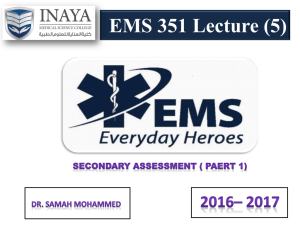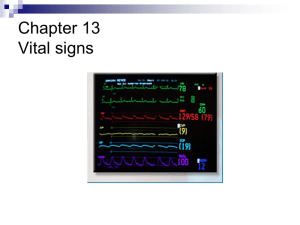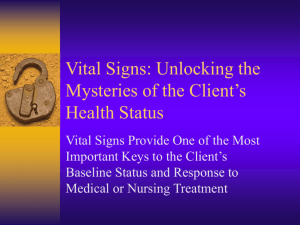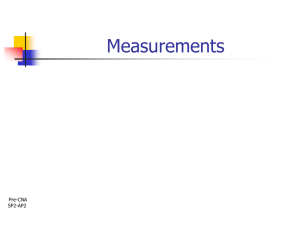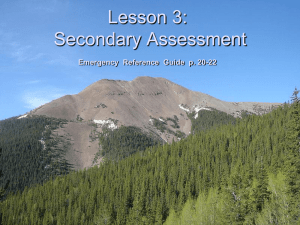CHAPTER 11 LECTURE NOTES – OBTAINING A MEDICAL
advertisement
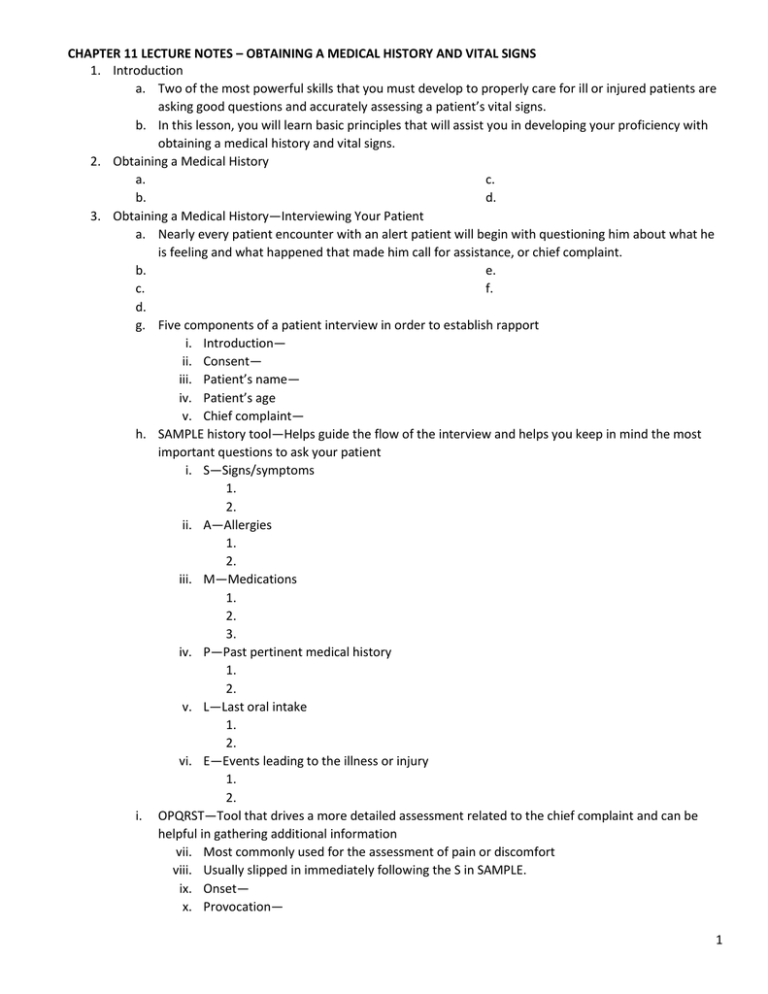
CHAPTER 11 LECTURE NOTES – OBTAINING A MEDICAL HISTORY AND VITAL SIGNS 1. Introduction a. Two of the most powerful skills that you must develop to properly care for ill or injured patients are asking good questions and accurately assessing a patient’s vital signs. b. In this lesson, you will learn basic principles that will assist you in developing your proficiency with obtaining a medical history and vital signs. 2. Obtaining a Medical History a. c. b. d. 3. Obtaining a Medical History—Interviewing Your Patient a. Nearly every patient encounter with an alert patient will begin with questioning him about what he is feeling and what happened that made him call for assistance, or chief complaint. b. e. c. f. d. g. Five components of a patient interview in order to establish rapport i. Introduction— ii. Consent— iii. Patient’s name— iv. Patient’s age v. Chief complaint— h. SAMPLE history tool—Helps guide the flow of the interview and helps you keep in mind the most important questions to ask your patient i. S—Signs/symptoms 1. 2. ii. A—Allergies 1. 2. iii. M—Medications 1. 2. 3. iv. P—Past pertinent medical history 1. 2. v. L—Last oral intake 1. 2. vi. E—Events leading to the illness or injury 1. 2. i. OPQRST—Tool that drives a more detailed assessment related to the chief complaint and can be helpful in gathering additional information vii. Most commonly used for the assessment of pain or discomfort viii. Usually slipped in immediately following the S in SAMPLE. ix. Onset— x. Provocation— 1 CHAPTER 11 LECTURE NOTES – OBTAINING A MEDICAL HISTORY AND VITAL SIGNS xi. Quality— xii. Region/radiate— xiii. Severity— xiv. Time— 4. Obtaining a Medical History—Additional Sources of Information a. If you encounter a patient who is or unable to answer your questions about his condition or history, gather information from family members, bystanders, or first responders. i. iv. ii. v. iii. b. Medical also can provide important information if the patient is unresponsive and a history cannot be easily obtained by those at the scene (e.g., medallion on a necklace, wrist, or ankle bracelet). 5. Vital Signs—An Overview a. b. A patient’s mental status, or (LOC), is commonly evaluated using the AVPU scale. It can give valuable information about the patient’s condition. i. A— ii. V— iii. P— iv. U— c. f. d. g. e. 6. Vital Signs—Respirations a. Respiration is the act or process of . b. Evaluate several characteristics when assessing a patient’s respirations: rate, depth, sound, and ease. i. ii. iii. iv. c. Steps for assessing respirations i. ii. iii. iv. d. Record your findings by documenting rate, depth, and ease. e. Normal range for respirations for an adult . 7. Vital Signs—Pulse a. b. c. d. When taking a patient’s pulse, assess for three characteristics. i. ii. iii. 2 CHAPTER 11 LECTURE NOTES – OBTAINING A MEDICAL HISTORY AND VITAL SIGNS e. When caring for a responsive patient, check the pulse at the patient’s wrist. The absence of a radial pulse when there is a carotid pulse indicates an abnormally low blood pressure and possible shock. i. v. ii. vi. iii. vii. iv. viii. f. For an unresponsive patient, check the pulse. g. The normal pulse rate for adults at rest is between 60 and 100 beats per minute. i. ii. iii. h. The primary pulse point for obtaining a pulse in infants under the age of one is the brachial pulse in the upper arm. i. ii. 8. Vital Signs—Capillary Refill a. d. b. e. c. f. g. Steps to assess capillary refill i. ii. iii. iv. h. i. 9. Vital Signs—Blood Pressure a. b. c. Blood pressure is determined by measuring the pressure changes in the arteries. i. iii. ii. iv. d. Normal blood pressure i. v. ii. vi. iii. vii. iv. viii. e. Determining blood pressure by auscultation i. ii. iii. To determine blood pressure using a blood pressure cuff and a stethoscope, do the following. 1. 5. 2. 6. 3. 7. 4. 8. 3 CHAPTER 11 LECTURE NOTES – OBTAINING A MEDICAL HISTORY AND VITAL SIGNS 9. 12. 10. 13. 11. 14. f. Determining blood pressure by palpation i. ii. Use this method when there is too much ambient noise to hear with a stethoscope. iii. Steps to determine blood pressure by palpation 1. 4. 2. 5. 3. 6. g. It may not be practical to obtain a blood pressure in children under the age of three. 10. Vital Signs—Skin Signs a. When assessing skin color in light-skinned patients, observe the skin of the face, noting if it appears pink (normal) or if it is pale or flushed or yellow. In dark-skinned patients, observe the palms, nail bed, inside of the lower lip (oral mucosa), or conjunctiva (tissue on the inside of the skin that surrounds each eye) to look for pink appearance. i. ii. iii. b. c. 11. Vital Signs—Pupils a. Size and shape i. ii. iii. b. Equality of pupil size i. ii. c. Reactivity to light i. ii. You can assess pupil reaction in two ways. 1. 2. In situations when there is not a lot of ambient light, an artificial light source (e.g., penlight or flashlight) will be necessary. a. b. c. iii. The acronym that is widely used in EMS is PERL. 1. P— 2. E— 3. R— 4. L— iv. Review Table 11.7 for observations you may make when assessing a patient’s pupils and possible causes. 12. Define the following terms: a. Auscultation: 4 CHAPTER 11 LECTURE NOTES – OBTAINING A MEDICAL HISTORY AND VITAL SIGNS b. Blood Pressure: c. Capillary Refill: d. Chief Complaint: e. Cyanotic: f. Diaphoretic: g. Palpation: h. Pulse: i. Respiration j. Stethoscope: k. Sign: l. Symptom: 5
